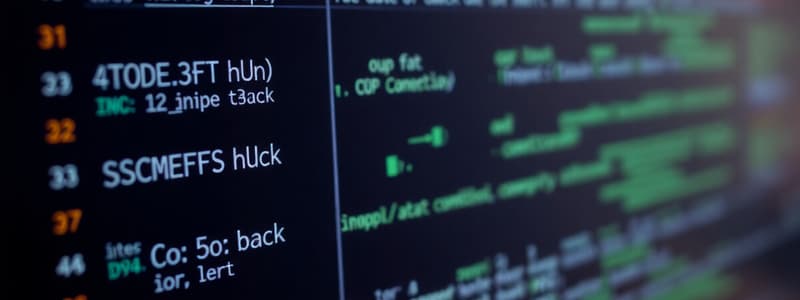Podcast
Questions and Answers
Scheduling is a fundamental Operating System function.
Scheduling is a fundamental Operating System function.
True (A)
Multiple processes can be in execution at the same time on a single CPU core.
Multiple processes can be in execution at the same time on a single CPU core.
False (B)
What is the purpose of a process scheduler?
What is the purpose of a process scheduler?
The process scheduler selects the next process to be executed on the CPU.
What is the name of the unit of CPU time that a process receives in a round robin scheduling system?
What is the name of the unit of CPU time that a process receives in a round robin scheduling system?
What is the disadvantage of using a very small time quantum in Round Robin scheduling?
What is the disadvantage of using a very small time quantum in Round Robin scheduling?
Shortest Job First (SJF) is a non-preemptive scheduling algorithm.
Shortest Job First (SJF) is a non-preemptive scheduling algorithm.
Match the scheduling algorithms with their descriptions:
Match the scheduling algorithms with their descriptions:
In multilevel queue scheduling, all queues must use the same scheduling algorithm.
In multilevel queue scheduling, all queues must use the same scheduling algorithm.
What is the main problem with Priority Scheduling?
What is the main problem with Priority Scheduling?
What is Aging in Priority Scheduling?
What is Aging in Priority Scheduling?
Multilevel Feedback Queue Scheduling is the most general CPU scheduling algorithm, but also the most complex.
Multilevel Feedback Queue Scheduling is the most general CPU scheduling algorithm, but also the most complex.
Flashcards
CPU Scheduling
CPU Scheduling
A fundamental operating system function that manages access to the CPU.
CPU Scheduling Algorithm
CPU Scheduling Algorithm
The process of selecting a process from the ready queue to execute on the CPU.
Ready Queue
Ready Queue
A set of all processes residing in main memory, ready and waiting to execute.
Wait Queue
Wait Queue
Signup and view all the flashcards
CPU Burst
CPU Burst
Signup and view all the flashcards
I/O Burst
I/O Burst
Signup and view all the flashcards
Process State Transition
Process State Transition
Signup and view all the flashcards
I/O-Bound Process
I/O-Bound Process
Signup and view all the flashcards
CPU-Bound Process
CPU-Bound Process
Signup and view all the flashcards
Dispatcher
Dispatcher
Signup and view all the flashcards
Dispatch Latency
Dispatch Latency
Signup and view all the flashcards
First-Come, First-Served (FCFS) Scheduling
First-Come, First-Served (FCFS) Scheduling
Signup and view all the flashcards
Shortest-Job-First (SJF) Scheduling
Shortest-Job-First (SJF) Scheduling
Signup and view all the flashcards
Shortest-Remaining-Time-First (SRT) Scheduling
Shortest-Remaining-Time-First (SRT) Scheduling
Signup and view all the flashcards
Round-Robin (RR) Scheduling
Round-Robin (RR) Scheduling
Signup and view all the flashcards
Time Quantum
Time Quantum
Signup and view all the flashcards
Priority Scheduling
Priority Scheduling
Signup and view all the flashcards
Starvation
Starvation
Signup and view all the flashcards
Aging
Aging
Signup and view all the flashcards
Multilevel Queue Scheduling
Multilevel Queue Scheduling
Signup and view all the flashcards
Multilevel Feedback Queue Scheduling
Multilevel Feedback Queue Scheduling
Signup and view all the flashcards
I/O Bound Process
I/O Bound Process
Signup and view all the flashcards
CPU Bound Process
CPU Bound Process
Signup and view all the flashcards
Preemptive Priority Scheduling
Preemptive Priority Scheduling
Signup and view all the flashcards
NonPreemptive Priority Scheduling
NonPreemptive Priority Scheduling
Signup and view all the flashcards
Priority Scheduling with Round Robin
Priority Scheduling with Round Robin
Signup and view all the flashcards
Multilevel Queue Scheduling
Multilevel Queue Scheduling
Signup and view all the flashcards
Priority Scheduling for CPU Bound and I/O Bound Processes
Priority Scheduling for CPU Bound and I/O Bound Processes
Signup and view all the flashcards
Dynamic Priority Scheduling with Aging
Dynamic Priority Scheduling with Aging
Signup and view all the flashcards
Automatic Resource Allocation
Automatic Resource Allocation
Signup and view all the flashcards
Resource Allocation
Resource Allocation
Signup and view all the flashcards
Study Notes
Operating Systems 24CSC1031
- Course taught by Wessam El-Behaidy, Associate Professor of Computer Science
- Main reference: Operating System Concepts, Abraham Silberschatz, 10th Edition
CPU Scheduling
- Scheduling is a fundamental operating system function.
- Almost all computer resources are scheduled before use.
- Multiprogramming loads several processes into memory simultaneously.
- Processes transition through various states (running, waiting, ready, etc.) throughout their lifetime.
- At any given time, only one process executes per CPU core.
- A process scheduler (CPU scheduler) selects the next process for execution on a given core.
- The ready queue holds all processes ready to execute in main memory.
- The wait queue holds processes waiting for events.
- Processes migrate among these queues as their state changes.
- Process execution cycles consist of CPU bursts followed by I/O waits.
- I/O-bound processes have many short CPU bursts.
- CPU-bound processes have a few long CPU bursts.
- The final CPU burst ends with a system request to terminate execution.
- CPU scheduling decisions are crucial based on the distribution of CPU burst duration.
CPU-Scheduling Components
- CPU scheduler (short-term scheduler) selects a process from the ready queue and allocates the CPU.
- The dispatcher gives control of the CPU core to the selected process, involving context switching, switching to user mode, and jumping to the appropriate location in the user program.
- Dispatch latency is the time it takes for the dispatcher to stop one process and start another.
- The dispatcher should be as fast as possible.
CPU Scheduler Decisions
- Scheduling decisions occur when a process switches from running to waiting, running to ready (e.g., interrupt), waiting to ready, or terminates.
- In situations 1 & 4, a new process (if available in the ready queue) must be selected for execution.
- The scheduling scheme can be either nonpreemptive or preemptive.
Nonpreemptive Scheduling
- Processes keep the CPU until they release it, either by terminating or switching to the waiting state.
Preemptive Scheduling
- In situations 2 & 3, the scheduling scheme is preemptive.
- Virtually all modern operating systems use preemptive scheduling algorithms.
- Preemptive scheduling can lead to race conditions when data is shared among multiple processes.
Scheduling Criteria
- CPU utilization: Keep the CPU as busy as possible (Maximize)
- Throughput: Number of processes completed per unit time (Maximize)
- Turnaround time: Amount of time to execute a particular process (Minimize)
- Waiting time: Time a process spends waiting in the ready queue (Minimize)
- Response time: Time from request submission until the first response is produced (Minimize).
CPU Scheduling Algorithms
- First-Come, First-Served (FCFS): The simplest algorithm, implemented as a FIFO queue, is nonpreemptive. A notable weakness is potentially long wait times for shorter processes behind longer-running ones, even the "convoy effect" if many I/O processes are competing with a long CPU process.
- Shortest-Job-First (SJF): Associates each process with the length of its next CPU burst and schedules the process with the shortest burst. Nonpreemptive. Typically optimal for minimizing average wait. Can be difficult to know length of next CPU burst.
- Shortest-Remaining-Time-First (SRT): Preemptive version of SJF.
- Round Robin (RR): Preemptive scheduling method that allocates a small time slice (time quantum) to each process in the ready queue. If the process doesn't complete in the time slice, it's moved to the end of the ready queue and a new process takes control of the CPU. Context switching is critical in the function of RR, which impacts performance based on its time quantum setting.
- Priority Scheduling: Each process has a priority number; the CPU is allocated to the process with the highest priority.
- Can be either preemptive or non-preemptive.
- Starvation can be a problem, so techniques like aging help.
- Shortest-job-first (SJF) can be implemented with priority scheduling.
- Priority scheduling with round robin combines the priority concept with round robin for fairness and reducing starvation risk.
- Multilevel queue scheduling and multilevel feedback queue scheduling arrange processes with different priorities on queues of various levels.
- Multilevel Queue Scheduling: The ready queue has multiple queues, each with a distinctive priority, and each queue has its own scheduling algorithm.
- Multilevel Feedback Queue: Processes can move between queues, and scheduling algorithms need to determine when to promote/demote a process to/from queues.
Reading List
- Silberschatz, Galvin, Gagne. Operating System Concepts, Tenth Edition, Chapter 5: CPU Scheduling (Sections 5.1 to 5.3)
Studying That Suits You
Use AI to generate personalized quizzes and flashcards to suit your learning preferences.




